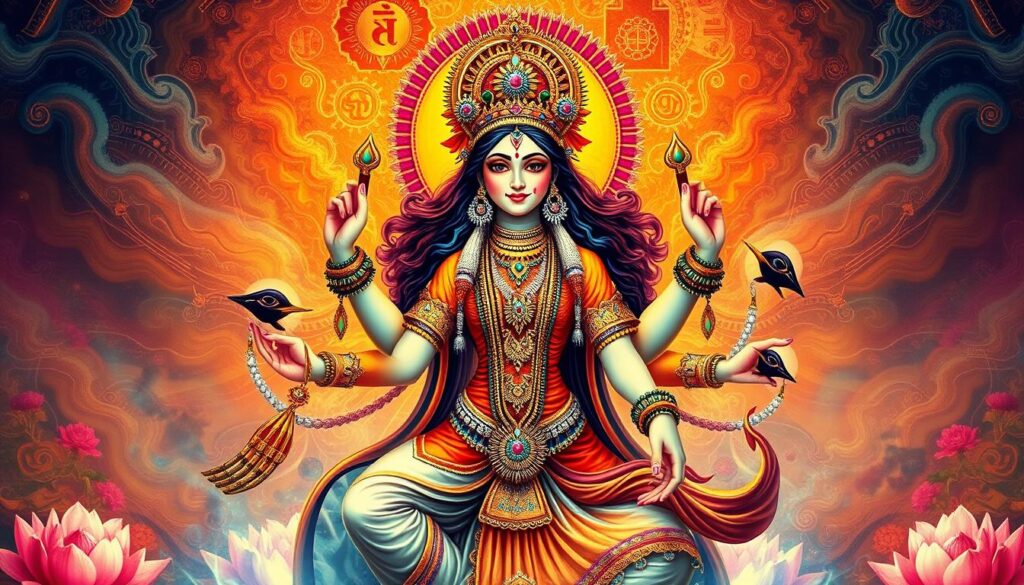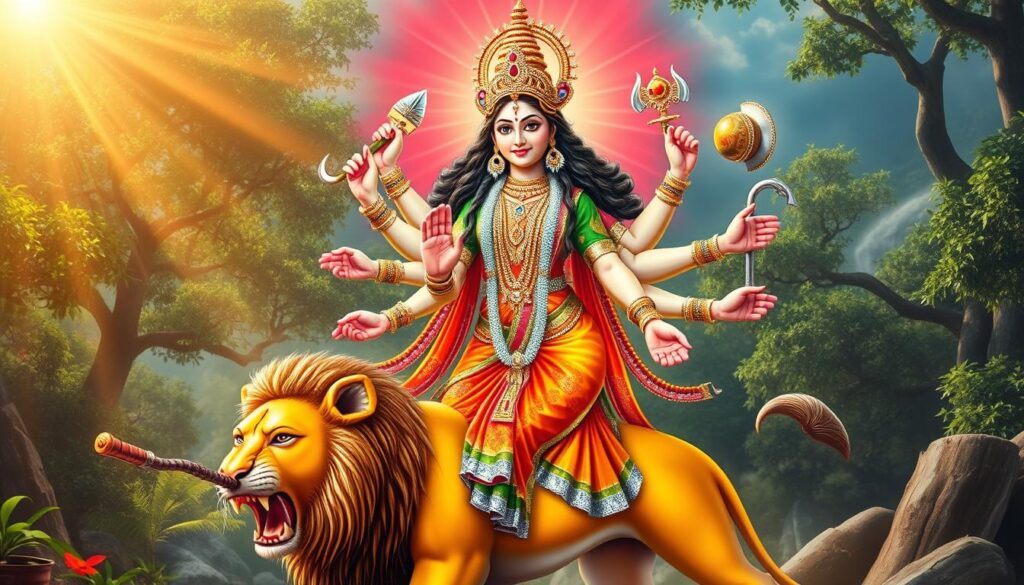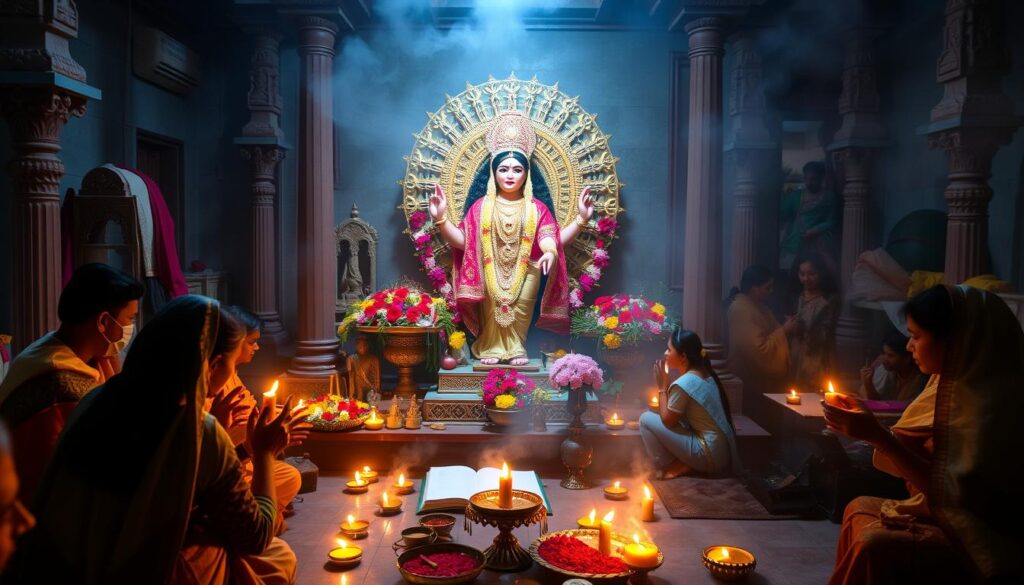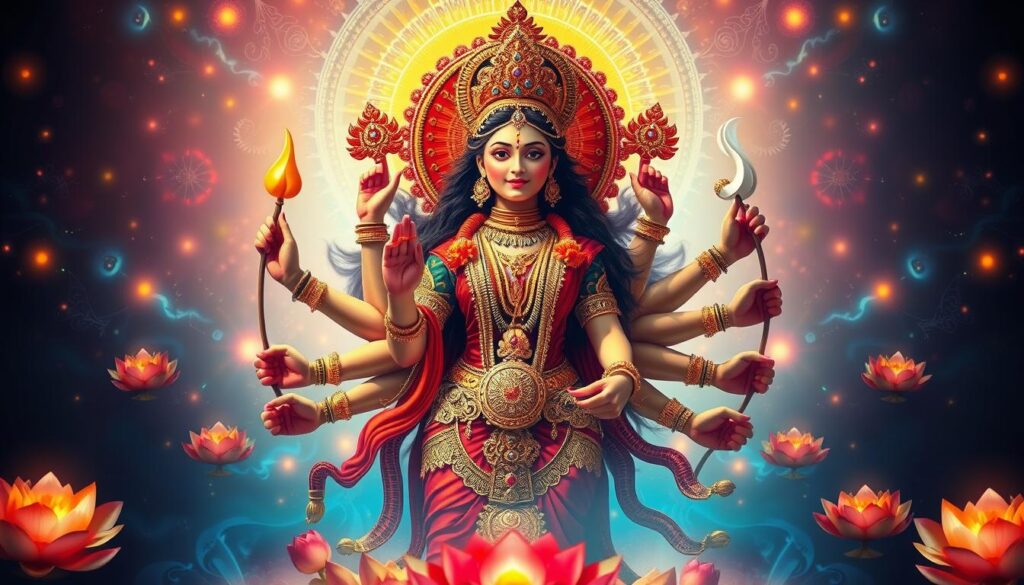Durga Saptashati is also known as Devi Mahatmyam or Chandi Path. It’s a Hindu scripture with 700 verses. These verses are dedicated to the hymns of devi, the Divine Mother.
This text tells the story of good winning over evil. It shows how the Goddess defeated many forms of Hindu scripture. The Durga Saptashati is a key book in the Shakti tradition. It honors the Divine Mother in all her forms.
The Durga Saptashati is very important in Devi worship. It talks about the power and virtues of the Divine Feminine. The sacred hymns in the text celebrate the Goddess’s role.
She is seen as the source of cosmic energy, a protector, and a giver of blessings. The text’s deep impact is seen in Hindu rituals and cultural traditions.
Introduction to Durga Saptashati
Durga Saptashati is a key Hindu scripture. It’s part of the Markandeya Purana, an ancient text. This text has 700 verses in 13 chapters. It’s a deep expression of devotion to Goddess Durga, the divine feminine power.
Historical Context
Durga Saptashati is important in the Shakta tradition. It focuses on the divine feminine. The text was written in the 6th century CE, but its roots go back to the Vedic era. The Markandeya Purana, with Durga Saptashati, is one of the oldest Hindu texts.
Importance in Hindu Tradition
The Durga Saptashati is very important in Hindu tradition. It’s especially important during Navaratri. Devotees chant these hymns to get Goddess Durga’s blessings.
The Chandi Homa is a ritual where 700 offerings are made to Goddess Durga. This shows how much people respect Durga Saptashati. The text also includes the Devi Suktam, Devi Kavacham, and Argala Stotram. These add to its spiritual value.
Durga Saptashati has inspired many art forms. This includes poetry, music, visual arts, and dance. Its lasting impact shows the deep respect for the divine feminine in Hindu tradition.
Structure of the Text

The Durga Saptashati is a sacred text from ancient Sanskrit. It has 13 chapters filled with powerful mantras and stories. At its core, it celebrates the divine feminine, showing the Goddess’s many forms and roles.
It tells of her battles against demons and her role in keeping the universe balanced. This text gives us a deep look into spiritual practices and empowerment mantras tied to the divine feminine.
Verses and Their Significance
The Durga Saptashati has 700 mantras. These are in different forms, like full Slokas and half Slokas. Each verse is seen as very important.
They are believed to bring protection, success, and spiritual growth to those who recite them with love.
Major Themes Explored
- The Manifestation of the Divine Mother: The text honors the Goddess in many forms, from fierce to nurturing.
- Cosmic Balance and the Triumph of Good: It shows the Goddess’s role in the fight between light and darkness. It highlights her role in bringing balance and righteousness.
- The Power of Devotion: The hymns talk about the power of devotion and spiritual practices. They show how empowerment mantras can change lives.
These themes and stories have touched many for centuries. They make the Durga Saptashati a precious source of spiritual wisdom and empowerment.
The Divine Feminine in Durga Saptashati

Durga Saptashati is a sacred Hindu text. It highlights the divine feminine energy called Shakti. Goddess Durga is seen as the supreme power, showing strength, courage, and wisdom.
The text talks about her different forms. Each form shows a different side of the divine feminine.
Concept of Shakti
The text says Brahman, the ultimate reality, and Shakti, the feminine energy, are the same. Brahman is the masculine, and Shakti is the feminine side of the divine. This idea of both sides being connected is key in Durga Saptashati.
Symbolism of Devi
Durga’s image, with her many arms and weapons, shows her power and protection. The text explores the Goddess Durga symbolism. It shows how her forms and attributes represent the divine feminine.
The Shree Durga Saptashati was written centuries ago. It’s a sacred Shakti text. It tells the story of Goddess Durga’s battles and her victory. This text is important in the Shakti tradition, connecting people with the divine feminine.
Rituals Associated with the Hymns
The recitation of the sacred Durga Saptashati is a key spiritual practice in Hinduism. It happens especially during the Navratri festival. People chant mantras like “Om Aim Hreem Kleem Chamundayai Vichche” to get the Devi’s blessings.
The timing of the devotional hymns is very important. Certain astrological periods are better for recitation. People follow rules like correct pronunciation and a respectful attitude to make these Hindu rituals more effective.
Recitation Practices
- Chanting the Devi Suktam, 8 verses from the Rig Veda, is a big part of Durga Saptashati recitation.
- People also chant the Durga Kavach, a 47-verse chant for protection, during their worship.
- The Devi Mahatmyam, with 700 mantras, is seen as a major mantra. It’s often chanted fully by devoted followers.
Timing and Astrological Considerations
The Durga Saptashati recitation is timed with good nakshatras and planetary positions. The Navratri festival, lasting 9 nights, is a special time for these devotional hymns.
Following specific rituals and astrological rules makes the Durga Saptashati’s spiritual practices more powerful. It brings more blessings and change.
Key Figures in Durga Saptashati

The Goddess Durga is at the center of the Durga Saptashati. She is seen as a protector and destroyer of evil. The text shows her as a symbol of power, wisdom, and grace.
Durga is shown in many forms, like Mahakali, Mahalakshmi, and Mahasaraswati. Each form highlights a different side of her divine energy.
The Durga Saptashati also talks about other important Hindu deities. They include Lord Vishnu, Lord Shiva, and Lord Brahma. These deities add their energies to Durga, making her even more powerful.
Goddess Durga
Goddess Durga is the main figure in the Durga Saptashati. The text tells of her battles against evil and her protection of the good. It describes her as a powerful being, with weapons and a lion mount. It also talks about her spiritual strength and wisdom.
Other Deities Mentioned
- Lord Vishnu, the preserver, adds his strength and wisdom to Durga.
- Lord Shiva, the destroyer, is often worshipped with Durga in Hindu traditions.
- Lord Brahma, the creator, gives his blessings and power to Durga, helping her fight evil.
The Durga Saptashati combines the powers of these deities. It shows how they work together in the fight between good and evil.
Benefits of Chanting Durga Saptashati

Chanting the Durga Saptashati hymns is believed to bring many benefits. This ancient Hindu text has 700 verses. It is known for its power to connect with the divine feminine energy.
Spiritual Enhancements
Reciting the Durga Saptashati regularly can improve your spiritual life. It boosts inner strength, clears your mind, and balances your emotions. The empowerment mantras in the text help you connect with the divine.
Chanting these devotional hymns can also bring the Goddess Durga’s blessings. This can protect you and fulfill your desires.
Physical and Emotional Healing
The Durga Saptashati is also linked to healing. People have reported better health and inner peace. Reciting the text can calm you and help you face life’s challenges.
The Durga Saptashati is a powerful path for those seeking spiritual growth. It offers a deep connection with the divine feminine. Engaging with its spiritual practices and devotional hymns and empowerment mantras can be transformative.
Addressing Common Misconceptions

The sacred Hindu scripture, Durga Saptashati, is often misunderstood. Some think it’s only for certain groups. Others believe it’s used for harm. But these are just myths.
In truth, the Durga Saptashati is a deep text for all who worship the divine feminine. Its hymns and mantras aim to empower and protect, not harm. They guide us on our spiritual path.
Myths vs. Facts
- Myth: Durga Saptashati is only for a select few or certain castes.
- Fact: The Devi worship and spiritual practices in the text are for all, no matter their background.
- Myth: The hymns are used for black magic or to harm others.
- Fact: These hymns aim to connect us with divine energy. They help us grow positive qualities and seek protection, not harm.
Clarifying Intent and Use
It’s key to understand the Durga Saptashati’s deeper meanings and symbols. The hymns and prayers are for connecting with the divine feminine. They teach us about righteousness, wisdom, and compassion.
By truly embracing the Durga Saptashati, we can unlock its transformative power. We can use these Hindu scriptures for our spiritual growth and the good of society.
Popular Verses and Their Meanings
The sacred hymns of Devi, found in the Durga Saptashati, are full of powerful mantras. These mantras have inspired spiritual seekers for centuries. Two notable verses are “Ya Devi Sarva Bhuteshu” and “Sarva Mangala Mangalye.”
Notable Mantras
“Ya Devi Sarva Bhuteshu” is a celebrated mantra. It praises the omnipresence of the Divine Mother. It sees the Goddess as the force behind all life, in every living being.
“Sarva Mangala Mangalye” is another revered verse. It talks about the Goddess’s blessings for prosperity and well-being. This mantra is often recited during Durga puja and other spiritual practices.
Interpretation and Application
The interpretations of these sacred hymns focus on recognizing the divine in life. By chanting these empowerment mantras, practitioners aim to grow spiritually. They seek a deeper connection with the Devi.
The practical use of these verses includes daily recitation for growth. They also help in overcoming challenges and achieving goals.
The Durga Saptashati is a deep source of inspiration. It offers a rich tapestry of sacred hymns and empowerment mantras. It helps those seeking to deepen their spiritual practices and experience the divine feminine’s blessings.
Modern Relevance of Durga Saptashati
Durga Saptashati is still very important today. Its spiritual lessons and themes of empowerment speak to people now. It has changed to meet the needs of today’s followers. It also keeps influencing Indian culture and the arts.
Adaptations in Contemporary Practices
Life moves fast, but people still find time for Durga Saptashati. They’ve made the old ways quicker or found new ways to fit it into their lives. The text’s messages about the divine feminine and winning over challenges are still inspiring today.
Influence on Culture and Arts
- Durga Saptashati’s stories and images have inspired many art pieces, like paintings and sculptures.
- Its themes of bravery, justice, and good winning over evil are seen in Indian movies, TV, and books.
- Festivals like Navaratri and Durga Puja, tied to Durga Saptashati, are lively celebrations of Hindu spiritual practices and cultural influence.
In today’s world, Durga Saptashati is a key for those wanting to connect with Hindu tradition. Its ability to adapt and continue influencing cultural influence and spiritual practices in India shows its lasting importance.
Tips for Beginners in Chanting
Starting to chant the sacred hymns of Durga Saptashati can change your life. For newbies, keep it simple and create a personal ritual. This is how you unlock the deep benefits of these spiritual practices.
Starting Simple
Beginners should start with easy devotional hymns like “Om Dum Durgayei Namaha.” Understanding the meaning of these verses makes the experience better. Learning the basics of Hindu rituals helps you connect deeper with the text.
Building a Personal Ritual
- Create a small personal altar or sacred space dedicated to the practice, adorned with images or icons of the Goddess Durga.
- Choose a specific time of day, such as early morning or evening, to consistently engage in the chanting ritual.
- Begin with a brief period of meditation or stillness to center the mind and heart before the recitation.
- Gradually increase the duration and complexity of the chanting practice as you become more comfortable and familiar with the text.
Creating a personal ritual deepens your connection with Durga Saptashati’s spiritual essence. It brings devotion and inner change. By starting with these steps, beginners can begin a fulfilling journey of spiritual practices and discover the power of these devotional hymns.
Conclusion: Embracing the Sacred Hymns
The Durga Saptashati is a key Hindu scripture. It offers a deep spiritual journey for those who want to connect with the divine feminine. Its wisdom and the study of Devi worship inspire and guide many.
By diving into these sacred hymns, readers can gain a deeper self-understanding. They also learn more about the universe.
Reflecting on Personal Connections
Exploring the Durga Saptashati opens a door to connect with the divine feminine. It highlights Shakti, the cosmic energy that supports all life. This encourages a deeper respect for the divine feminine’s power and sacredness.
Readers are asked to think about how these hymns relate to their spiritual paths. They can also think about how to apply the Devi’s wisdom in their daily lives.
Encouragement to Explore Further
The Durga Saptashati is full of spiritual insights. Its exploration goes beyond this article. Readers are urged to keep learning, seeking help from wise teachers and spiritual guides.
By embracing Devi worship and the Durga Saptashati, people can grow spiritually. They can find a path to personal growth, spiritual awakening, and a closer bond with the divine.

